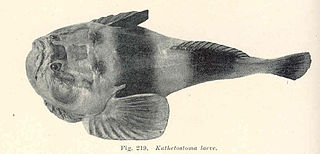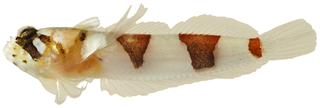
The stargazers are a family, Uranoscopidae, of perciform fish that have eyes on top of their heads. The family includes about 51 species in eight genera, all marine and found worldwide in shallow and deep saltwaters.

"The Battle" is the ninth episode of the first season of the American science fiction television series Star Trek: The Next Generation and was originally aired on November 16, 1987, in broadcast syndication. The episode was written by Herbert Wright, based on a story by Larry Forrester, and directed by Rob Bowman.
The Stargazers were a British vocal group, jointly founded in 1949 by Cliff Adams and Ronnie Milne. Other original members were Marie Benson, Fred Datchler and Dick James.

Mobile Suit Gundam SEED C.E. 73: Stargazer is a side story to the anime television series Mobile Suit Gundam SEED Destiny. In July 2006, it began streaming on Bandai Channel website as an original net animation. The show is directed by Susumu Nishizawa and written by Shigeru Morita, both staff members of Gundam SEED Destiny.

Sassacus is a genus of jumping spiders that was first described by George and Elizabeth Peckham in 1895. It is likely named after Sassacus, a Native American chief of the 16th and 17th century.

In biology, the electric organ is an organ that an electric fish uses to create an electric field. Electric organs are derived from modified muscle or in some cases nerve tissue, called electrocytes, and have evolved at least six times among the elasmobranchs and teleosts. These fish use their electric discharges for navigation, communication, mating, defence, and in strongly electric fish also for the incapacitation of prey.

Stargazer is a Lockheed L-1011 TriStar built in 1974, that was modified in 1994 for use by Orbital Sciences as a mother ship for the Pegasus, a small-lift launch vehicle. As of October 2022, 45 rockets have been launched from Stargazer. Stargazer is the only L-1011 airframe still airworthy.

Platygillellus is a genus of sand stargazers native to the Atlantic and Pacific coasts of the Americas.
Dactyloscopus foraminosus, the reticulate stargazer, is a species of sand stargazer native to the coastal waters of Brazil where it can be found at depths of from 11 to 79 metres. This species may also occur off the coast of Florida, United States. It can reach a maximum length of 7.9 centimetres (3.1 in) NG.
Dactyloscopus tridigitatus, the sand stargazer, is a species of sand stargazer native to the Atlantic coasts of the Americas from Florida, United States to Brazil as well as in the Caribbean Ocean and the Gulf of Mexico. It is found in sandy areas around reefs at depths of from 0 to 29 metres. It is an ambush predator, burying itself nearly completely in the sand and attacking prey animals that happen by. It can reach a maximum length of 9 centimetres (3.5 in) TL.
Gillellus greyae, the arrow stargazer, is a species of sand stargazer native to the Atlantic coast of the Americas from Florida, United States to Brazil including the Bahamas and Cuba where it can be found in sandy patches on reefs. It can reach a maximum length of approximately 9 centimetres (3.5 in) TL. This species can also be found in the aquarium trade. The specific name honours the American ichthyologist Marion Griswold Grey (1911-1964) of the Division of Fishes at the Field Museum of Natural History in Chicago, Illinois.
Platygillellus brasiliensis, the Brazilian sand stargazer, is a species of sand stargazer native to the Atlantic coast of Brazil where it can be found at depths of from 1 to 6 metres in areas with gravel substrates in which it buries itself almost completely except the eyes and the dorsal finlet. Males of this species can reach a maximum length of 4.1 centimetres (1.6 in) SL, while females can reach a maximum length of 4.0 centimetres (1.6 in) SL.

The southern stargazer is a species of marine fish in the family Uranoscopidae and genus Astroscopus. They are native to the United States.

Astroscopus, the electric stargazers, is a genus of stargazers, a type of percomorph fish from the family Uranoscopidae, part of the order Labriformes. The species in this genus are anatomically distinct uranoscopids, being characterized by internal nares and being the only group of marine bony fish having organs which produce electricity which are derived from the extraocular muscles. They are found on the Atlantic and Pacific coasts of the Americas.
Yam Haus is an American indie pop-rock band with member Lars Pruitt (vocals), Jake Felstow (drums), and Zach Beinlich (bass). The band is currently signed to Big Loud Rock under Big Loud Records.

Scolopocryptops sexspinosus, the eastern red centipede, is a species of centipede in the family Scolopocryptopidae. It is found in North America. It is the only scolopendromorph definitively found in Canada. Canadian specimens appear to be most abundant in British Columbia and Vancouver Island. It is widespread across eastern North America from far southern Canada to the Carolinas and the Gulf Coast, and prefers hiding under rotting wood or leaf litter ; it is thus difficult to find.

The Hyundai Stargazer is a compact multi-purpose vehicle (MPV) produced by Hyundai Motor Company in Indonesia since 2022. The vehicle was first introduced on 15 July 2022 when the first units of the vehicle rolled off its assembly line at HMMI in Cikarang. It was launched and made its public debut at the 29th Gaikindo Indonesia International Auto Show on 11 August.
The Guennol Stargazer is a nine-inch, 5,000-year-old marble idol from Anatolia.











